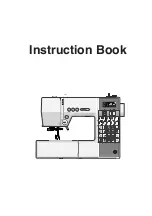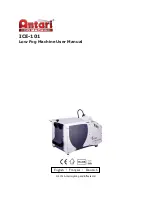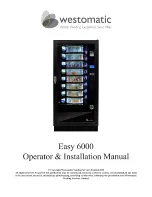
W
Lay cables and lines so that they cannot be damaged and no one can trip over them.
W
Before commissioning, make sure that all seals and caps for the screwed
connections are correctly installed and undamaged to prevent fluids and foreign
bodies from penetrating the product.
W
Only use protective extra-low voltage (PELV) and ensure safe electrical isolation
of the operating voltage in accordance with EN 60204.
W
For highly contaminated vacuum/ambient air, use a VFC vacuum filter (cup
version) between the vacuum connection and volumes to be evacuated.
During commissioning
W
Make sure that all electrical and pneumatic connections are either used or
covered. Commission the product only if it is installed completely.
During operation
W
Only use compressed air in accordance with ISO 8573-1: 2010 (max. particle size:
5 μm; pressure dew point:
d
3 °C; oil content: 0 mg/m
3
– 1 mg/m
3
).
W
Do not use the ejector in environments that are not splashwater-proof.
During cleaning
W
Seal all openings with suitable protective caps to prevent detergents from
penetrating the system.
W
Never use solvents or strong detergents. Only clean the product using a slightly
damp cloth. Only use water and, if necessary, a mild detergent.
W
Do not use a high-pressure cleaner for cleaning.
During maintenance and repair
W
Make sure that no cable connections, ports, or components become loose while
the system is under pressure and voltage. Protect the system against being
switched on.
During disposal
W
Dispose of the product in accordance with the currently applicable national
regulations in your country.
3
Delivery Contents
W
ECS compact ejector, PE3 pressure sensor, cables and assembly parts
in ordered version
W
Operating instructions, ECS compact ejector, R412004317
W
Operating instructions, PE3-P2 pressure sensor, R412004321
(depending on the version)
W
Operating instructions, PE3-PV pressure sensor, R412004326
(depending on the version)
4
About This Product
Performance description
The ejector is used for vacuum generation, i.e. the evacuation of suction grippers
used to hold useful loads or other volumes. The ejector is supplied with compressed
air via the compressed air connection (
8
). The compressed air flowing through
generates a vacuum at the nozzle (Venturi principle) and is blown to the outside via
a silencer (
6
). The vacuum is provided to the vacuum network via the vacuum
connection (
4
).
Further functions:
W
The vacuum can be switched via a solenoid valve (
9
).
W
The release pulse can be switched via a solenoid valve (
10
).
W
A pressure sensor (
2
) makes it possible to recognize the presence of a vacuum
and generate two output signals.
W
The air economizer (
1
) is an integrated control, used to control the vacuum in an
energy efficient way via the output signal OUT 1 of the pressure sensor.
Only suitable for applications with leaktight and smooth surfaces!
ECS... NO ...
To prevent an inefficient blow-off during suction, voltage must be applied to both
solenoid valves simultaneously to achieve the “
release pulse ON
” state
(blow-off)
.
ECS... NC ...
Always apply the supply voltage to the solenoid valves alternately to ensure non-
overlapping suction
(vacuum ON)
or
blow-off (release pulse ON)
.
ECS... with internal regulation (...RE/RD versions)
The switching frequency and therefore air savings depend on the surface and
leaktightness of the workpiece to be suctioned or the area to be evacuated.
Extremely porous workpieces can result in a relatively high switching frequency; air
savings is minimal and wear-related strain on the device can increase.
When modifying the adjustment range, make sure that the hysteresis is not too
small, which results in an increased switching frequency, and not too large, which
reduces the bearing capacity, e.g. when the bottom switch-on point of the regulator
is below the minimum vacuum level required for the system configuration.
1
ECS... RD
The device transmits a
digital
auxiliary signal for processing in an external control
(e.g. PLC), which can be used to monitor the internal control loop. Programming can
be carried out independently from the internal control loop.
When adjusting the presetting, note that for its monitoring function, the auxiliary
signal should always be slightly below the lower switch-on point of the internal
control loop (switching point “H” minus hysteresis “h”).
ECS... RE
The device transmits an
analog
auxiliary signal in the range from +1 to +5 V, which
cannot be set independently from the internal control loop.
The voltage output level is proportional in pressure to the selected internal adjustment
range. Note that the signal output only occurs during
air economizing pauses
.
Product overview
5
Assembly
The dimensioned drawings of the ejectors can be found online at
www.aventics.com/pneumatics-catalog.
Unpacking
Dispose of the packaging in accordance with the currently applicable national
regulations in your country.
Assembling the ejector
Fastening the ejector
O
Fasten the ejector on the base with at least 2 mounting screws (ECS...10/15:
M4x25, ECS...20/30: M5x30) and the suitable flat disks using the through holes
Connecting the ejector pneumatics
1.
Make sure the relevant system part is not under pressure.
2.
Lay the tubes so as not to bend or crush them.
Symbols
Ejector
Ejector: connecting the compressed air and vacuum
1.
Insert the fittings (
2
) (provided by customer) in the compressed air connection (
3
)
and vacuum connection (
4
).
2.
Insert the compressed air tube (
1
) and the vacuum tube (
5
) in the appropriate
fitting (
2
).
Use the following tube inside diameter:
The recommended tube diameter is based on a max. length of 2 m. Use the next
largest tube diameter for lengths > 2 m.
W
If the diameter selected for the compressed air tube (
1
) is too small, the ejector
will not be supplied with enough compressed air to ensure optimum operation.
W
If the diameter selected for the vacuum tube (
5
) is too small, the flow resistance
along the tube walls will be too high, resulting in a negative effect on the suction
capacity and evacuation times. Simultaneously, the high flow resistance also
causes an increase in release pulse times.
1
Air economizer (optional: ECS...R)
2
PE3 pressure sensor
(optional: ECS...D/E)
3
Ejector housing
4
Vacuum connection (G1/8)
5
Filter
6
Silencer
7
SilencerThrough holes for mounting
screws (
4.5)
8
Compressed air connection (G1/8)
9
Solenoid valve for “vacuum”
10
Solenoid valve for “release pulse”
NOTICE
Missing seals and plugs result in non-compliance with the protection class
1)
!
Liquids and foreign objects could penetrate and destroy the product.
O
Before commissioning, make sure that all seals are firmly fitted and the
connection plugs are leaktight.
1) IP 40 for ECS...10/15, IP 65 for ECS...20/30
NO = Normal position, solenoid valve for “vacuum”, open without current
NC = Normal position, solenoid valve for “vacuum”, closed without current
I
= Solenoid valve for release pulse
S
= Integrated non-return valve
D
= With PE3-P2 pressure sensor (2x PNP) – standard display
E
= With PE3-PV pressure sensor (2x PNP, 1x analog) – LED display
Ejector
Compressed air tube (1)
Vacuum tube (5)
ECS...10
Ø 2 mm
Ø 4 mm
ECS...15
Ø 4 mm
Ø 6 mm
ECS...20
Ø 6 mm
Ø 9 mm
ECS...30
Ø 9 mm
Ø 12 mm
1
2
3
4
5
AVENTICS
| ECS | R412004317–BDL–001–AE | English
6








































